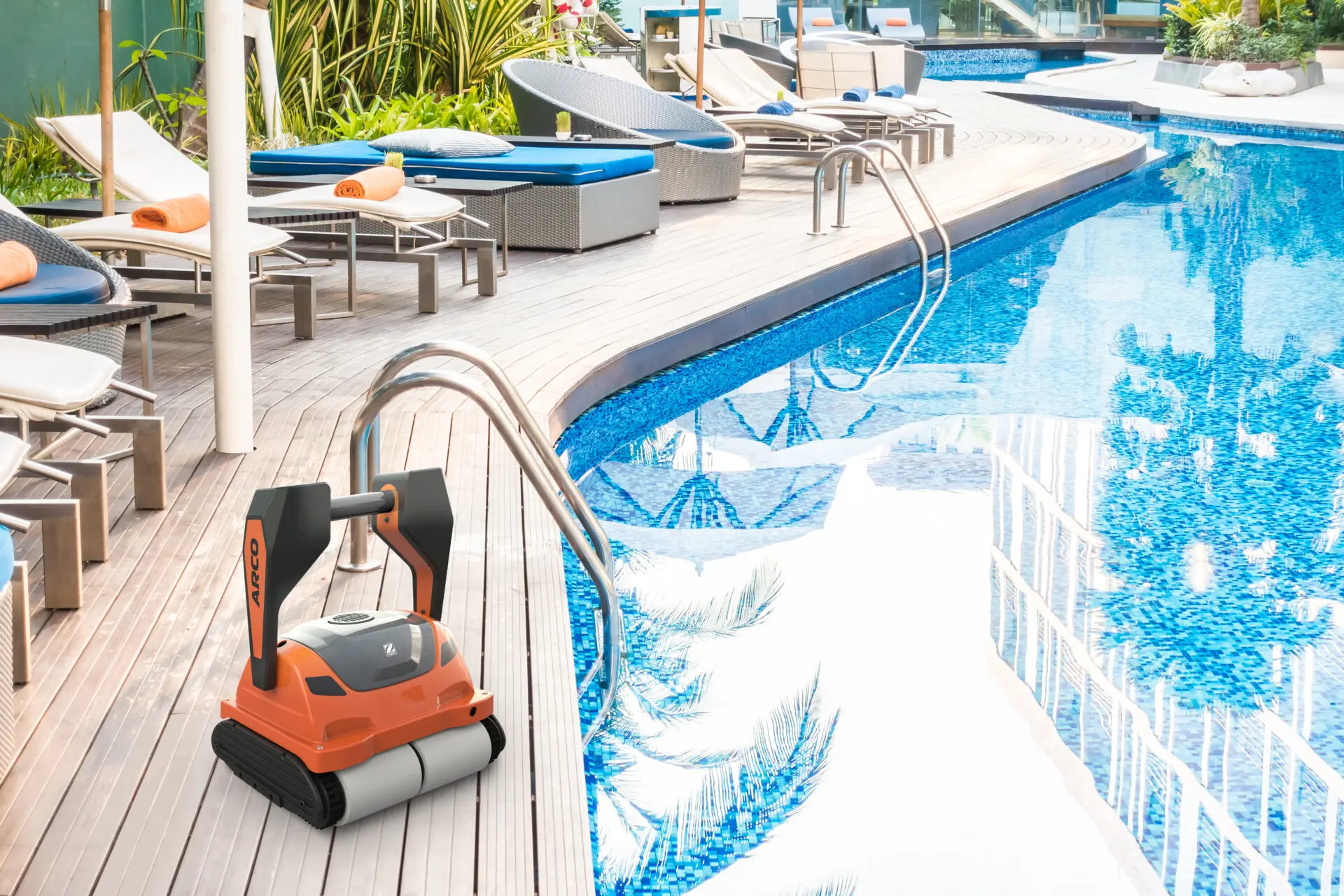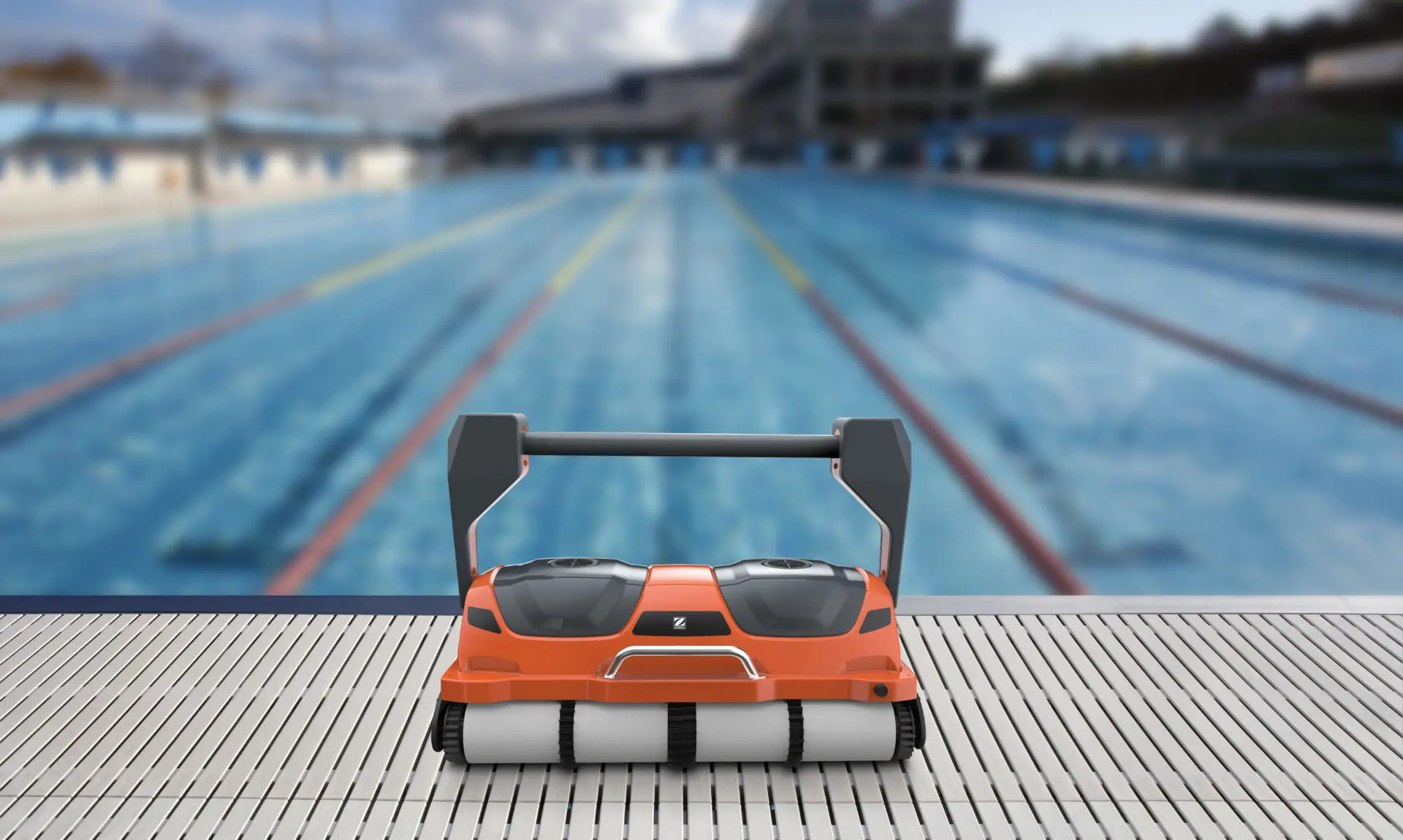Keeping a swimming pool clean involves more than just treating the water to ensure it has the optimal pH balance and the right chemicals to keep it clean and safe for swimmers and bathers. External debris and dirt accumulate in outdoor swimming pools, while indoors, you have to contend with lots of small particles that build up over time, as well. Both indoor and outdoor pools also pick up small amounts of grime and dirt from the users’ bodies, which are also small enough to ignore at the start, but can build up significantly over longer periods of time.
A pool vacuum is an essential tool for pool operators to ensure their facility’s cleanliness, in both indoor and outdoor pools, and whether the pool is above ground or in-ground.
In this article, we’ll look into the details of vacuum cleaners for pools and help you choose the optimal solution for yours.
Dive deeper with the eBook
What is a pool vacuum cleaner?
A pool vacuum is a cleaning device designed to remove debris, dirt, and grime from your pool basin. The vacuum works by creating suction that sucks up debris from both the pool floor and its surrounding walls. It is a must-have tool for pool owners who want to keep their pool clean and hygienic.
Dirt on any surface can affect water quality via the proliferation of algae and unhygienic bacteria. Neglecting dirty pool floors or walls can also cause cloudy water and green water to appear, or the pool basin and accessories to deteriorate sooner. Therefore, it is vital to clean the entire pool shell periodically. A pool vacuum offers a convenient and easy-to-use solution for this.
The benefits of having a pool vacuum include:
- Reducing the need for chemical disinfection of the pool, thanks to keeping the water cleaner overall
- Reducing the need to top up the water volume
- Lower energy consumption
- Less need for filtration
- Reduced wear and tear on the overall installation
Having less debris and bacterial build-up on the pool shell leads to cleaner water and a reduced need to recirculate, filter, and treat it.

Types of vacuum cleaners for pools
When it comes to choosing a vacuum for your pool, you’ll need to consider the size of your pool, as well as how intensely used it is. The purpose of the pool (sports training, leisure, etc.) will also influence what type of pool vacuum you need.
The main difference in the market is between vacuums designed for relatively small pools, used in residential or private environments, and those designed for heavy-duty use in large public pools with more users.
Here are the typical pool vacuums available on the market:
- Manual pool vacuum: This is the most basic type. It is a simple, affordable, and effective tool that you can use to clean your pool. The manual vacuum needs to be attached to the pool’s skimmer and moved around manually to clean the pool’s floor and walls.
- Automatic pool vacuum: Also called a robotic pool vacuum, this is the most advanced type of pool vacuum. An intelligent, self-contained unit, it uses advanced technology to clean your pool. The robotic vacuum is powered by electricity and has its own motor, filter, and navigation system. It can clean the pool floor, walls, and waterline with ease, without any manual intervention. Some models even work without the need to be connected by cable.
Automatic pool vacuums come in two main types: hydraulic (suction or pressure) or electric. Each model will have different functions and different levels of intensity, speed, and autonomy. The most advanced models can even move freely up and down the pool walls, exiting the pool on their own.
- Electric pool vacuums are connected to the power supply, which makes them completely independent of the pool’s filtration circuit. This means using them is almost effortless, with reduced water and energy consumption. Unlike other types of vacuum, they store the debris in their own filter. Overall, their high performance, durability, efficiency, and greater sustainability can offer a very good ROI for pool operators.
- Hydraulic pool vacuums are available in two subgroups: suction and pressure. Suction equipment is connected to the pool vacuum intake or the skimmer. These vacuums are powered by the filtration system and clean the bottom and walls of the pool shell at random times. Pressure vacuums, on the other hand, are connected to the pool water return. They usually require installation of an extra pump and feature some filter bags to store solid impurities.
How does a pool vacuum work?
Just as the name suggests, a pool vacuum works through suction – picking up debris from the pool floor and walls.
How to use a pool vacuum?
Using a pool vacuum is a simple and straightforward process. Here is a step-by-step guide that will apply to the majority of manual models:
- Step 1: Turn off your pool pump
- Step 2: Attach the vacuum head to the telescoping pole
- Step 3: Attach the vacuum hose to the vacuum head
- Step 4: Lower the vacuum head into the pool
- Step 5: Attach the opposite end of the vacuum hose to the vacuum port on your pool’s filtration system
- Step 6: Turn on the pool pump
- Step 7: Move the vacuum head slowly around the pool, cleaning the floor and walls (for a manual vacuum)
- Step 8: Once you have cleaned the entire pool, turn off the pump and disconnect the vacuum hose and head.
In the case of robotic or automatic pool vacuums, you just have to make sure they have enough battery and capacity in the tank, turn them on and put them in the pool. Once their cleaning cycle is over, you will need to remove them from the pool by picking up the cable. Some newer models allow the pool vacuum to lift itself out of the pool as well.

Picking the best vacuum cleaner for commercial pools
Automatic pool vacuums represent the most efficient, convenient, and long-term effective investment for the maintenance of a commercial pool. Fluidra offers a range of expertly designed Zodiac® electric automatic pool vacuums that can cover any requirements.
With multiple features, premium quality, greater robustness and high efficiency, Zodiac vacuums will clean the entire pool shell for commercial installations such as at hotels, campsites, sports centres, and water parks. They also benefit from an intelligent and efficient design, allowing them to move well and be easy to transport and store.
The four electric models are grouped into two series:
VORTRAX
For daily maintenance in pools of up to 25 metres, we recommend the TRX 7500 iQ and TRX 7700 iQ models from the Vortrax range. Their powerful cyclonic suction efficiently sucks up all dirt, while the dual-stage level filtration from 60 to 150 microns allows for the collection of debris of all sizes. This doubles the filtration surface area and, in turn, reduces the frequency with which you need to clean the filter.
ARCO
Designed for intensive daily use in medium and large public pools of up to 50 metres in length, the ARCO and ARCOMAX models are an ideal solution for professional use, collecting all types of debris at swimming clubs, sports centres, hotels, and campsites.
